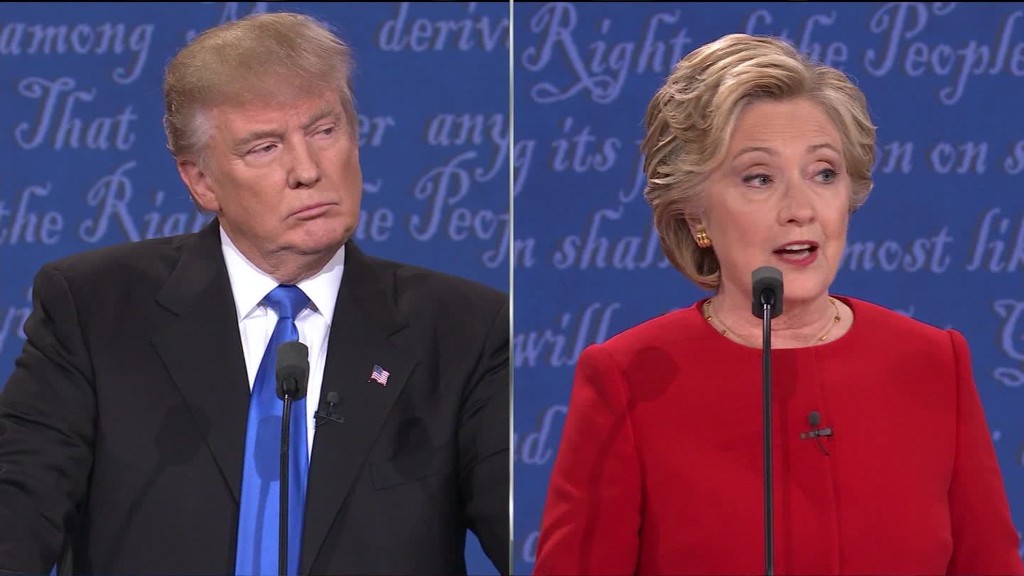
Donald Trump paints global trade as a zero-sum game. They win, America loses.
"We have to stop these countries from stealing our companies and our jobs," Trump said at the debate last week.
Trump routinely threatens to slap stiff tariffs, or taxes, on China and Mexico. He also says he would entirely renegotiate or "terminate" NAFTA, label China as a currency manipulator, and get rid of America's "stupid" trade negotiators.
Ahead of the vice presidential debate Tuesday evening, here are the realities on at least two of Trump's trade claims:
Trump myth I: America is losing money to Mexico, China and others
The formal term is a trade deficit, which is when a country imports more goods than it exports to other countries.
Trump says a trade deficit "is like having a business that continues to lose money every single year...Who would do business like that?"
Reality: There's no proof that a trade deficit is bad for an advanced economy like the United States.
For example, Australia has had a trade deficit for the last 25 years, IMF figures show. It also has not had an economic recession for 25 years, a very long streak for any country.
Japan, in fact, has had a massive trade surplus over the last 25 years, meaning it exports more than it imports. And Japan's economy has been crushed by stagnant growth for decades.
Related: 'Without NAFTA, we'd be out of business'
Why isn't a trade deficit so bad? Because when other countries export more to the U.S., they tend to invest more too and that helps create new jobs.
In 1994, the year NAFTA became law, Mexico invested $2 billion in U.S. businesses. Last year, it invested $16.5 billion, mostly in -- wait for it -- manufacturing jobs in America, according to the U.S. Trade Representative.
America's trade deficit has ballooned over that time too. It's grown during good times and bad. Even when the U.S. economy grew at a healthy 4% pace, the deficit grew.
The trade deficit actually plummeted between 2006 and 2009 -- but not for good reasons.
"The trade deficit usually increases when the economy is growing and creating jobs and decreases when it is contracting and losing jobs," says Doug Irwin, a trade expert at Dartmouth College, who worked on President Reagan's trade team in the late 1980s.
Trump myth II: Trade with Mexico is a U.S. job killer
"Our jobs are fleeing the country. They're going to Mexico," Trump said last week.
Reality: Not really. About six million American jobs rely on trade with Mexico, according to the U.S. Chamber of Commerce.
On top of that, many U.S. businesses rely on Mexico. Consider this: for every dollar of goods Mexico sells in the United States, 40 cents of that dollar goes to U.S. businesses that ship parts and products to Mexico.
America sends more goods to Mexico than it does to China, India, Russia and Brazil combined, according to Carla Hills, a former U.S. trade representative under President George H. W. Bush. All those exports support American jobs.
Related: Trump slams America's 'worst deal ever'
"The market openings [NAFTA] created have generated more export-related jobs in the United States," says Hills.
It is true that trade with Mexico has cost some Americans jobs. Carrier is moving 1,400 jobs to Mexico from Indiana. Robert Scott, an economist at the Economic Policy Institute estimates that America lost about 800,000 jobs to Mexico between 1997 and 2013.
However, the growing trade ties between the two countries have created more jobs than they've killed, other experts argue.
Even a nonpartisan analysis of NAFTA by the Congressional Research Service found that the deal isn't responsible for a mass exodus of American jobs and it's actually had a small, positive impact on the U.S. economy.


